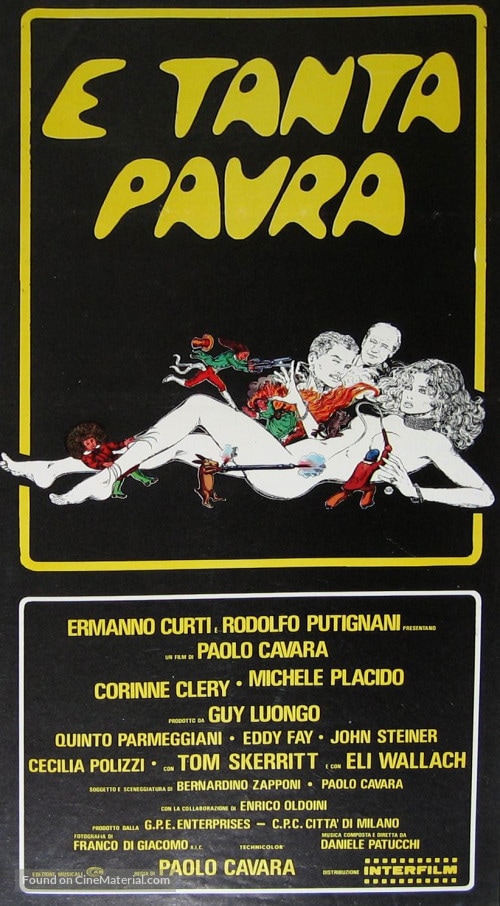Plot of Fear details the murder of several former members of a private 'Fauna Club', a society set up in Naples to either appreciate animals, appreciate plants, import animals, take drugs, have sex or smuggle diamonds. The killer leaves a page from an old children's book, Struwwel Peter, at the scene of most of the murders. A few years previously, a young prostitute died at a meeting of the Fauna Club, in mysterious circumstances. Both the detective who investigated the crime and the police dossier he had compiled have disappeared, leaving Michele Placido's Inspector Lomenzo struggling to make sense of everything. Lurking in the background is Eli Wallach's character, Peter Struwwel (interesting name, eh?), who runs a private security firm, and wields much influence in the corridors of Neopolitan power.
The investigative aspect of the film is fairly weak, with several unlikely contrivances (the vanished detective happens to leave his diary in his former residence; Lomenzo's neighbour, and lover, happens to have been at the centre of the Fauna Club, etc), but there's still plenty to admire. There are several scenes with breathtaking cinematography, with a couple set in icy fog being beautifully stark, and a climactic scene set in a hall of mirrors (in a literal sense; a hall which has a lot of mirrors in it) contains one of the best shots in Italian genre history.
The motive driving the killings is rooted in an incident which took place several years previously, as it is in many gialli. Plot of Fear takes a slightly different approach to most of its contemporaries, however; it asks several philosophical questions (without necessarily forcing us to answer them, or an answer upon us). The owner of the villa at which the Fauna Club meets is the son of Nazis, and the decadent behaviour indulged in by the club's members is redolent of the worst excesses of wartime criminals (and that of the ruling classes of Salo, which was released the previous year). I've said before that the transition from money to guilt-specifically guilt rooted in the past-as the leading motive for killers is came with the rise of the younger, Argento-led generation. These directors were born in and around WW2, and as they matured they presumably tried to make sense of their parents' history, and these concerns can be detected in their films. (Although Paolo Cavara himself was 13 when the war started.) From the mid-70s onwards, probably inspired by the aforementioned Pasolini film, as well as the brief fad for Nazisploitation films, gialli began engaging far more directly with the war than they previously had (c.f. The Cat's Victims). There was a greater willingness to examine past sins, and a greater desire to punish those responsible (the Nazi Hunters were in their pomp in the 60s and 70s too).
This aspect of punishing those responsible is where the real philosophical questions at the heart of Plot are to be found. The people who are murdered are all guilty themselves of a prior murder. They are apparently untouchable by common law, so drastic measures must be taken. In effect, the film asks if it's wrong to murder a murderer, if the murderer has not paid for their crimes. There's also a subtext of the increasing licentiousness and hedonism of the post-60s world, with several older characters expressing disgust at the immorality of the younger generation. Inspector Lomenzo himself belongs to this generation, swapping girlfriends mid-film, although not fully by choice (his first one leaves him for a photographer). He tries to assert his male power throughout the film (eg insisting that he likes to have sex before falling asleep), but is repeatedly undercut (eg his girlfriend makes it clear that if they do have sex, it'll be on her terms. Both women he has sex with go on top, too). There's a great moment where Lomenzo declares that he'll fight anyone who dares to try to take his new girlfriend away, only to immediately stand back, cowed, as a large man cuts in to ask her for a dance. So the character has far more depth and ambiguity than the macho cops at the heart of the then-popular poliziotteschi.
The film isn't necessarily agreeing with all the condemnation of the indulgences of youth, though (unlike a lot of Italian films, which adopt such a prurient attitude whilst simultaneously ogling the female form). The men at the heart of the club, and original crime, are of the older generation, and are at least as immoral as the youths. The only character to show any true remorse or grief is the dead prostitute's young(ish) pimp, who didn't even have anything to do with her murder. And the oldest character in the film, one of the club members' mothers, is among the most unlikeable of them all, even though, again, she had nothing to do with the murder.
Peter Struwwel and his bank of monitors also anticipates the Big Brother phenomenon, and raises questions as to the right for privacy, and consequently forgiveness for past sins. If someone knows everything you've done in your life, are you always presently responsible for your past actions?
The direction and approach the film takes shows a lot of imagination, even if that same quality is lacking on the part of the investigators-the police know that one of the murder victims had herself killed one of the earlier victims, but they still refuse to countenance the possibility of there being more than one other killer (as it turns out, they're [probably] correct). As a murder-mystery giallo, it's probably upper-middle tier. But if you want something which burrows a little deeper than usual, and serves up several issues which are as relevant today as ever (with the internet recording our lives much as Struwwel's surveillance system did), then you'll get a lot out of this film.

 RSS Feed
RSS Feed
